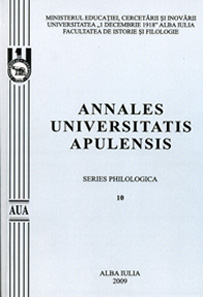EQUIVALENCES TERMINOLOGIQUES DANS LES TEXTES REGLEMENTAIRES DU XIXE SIECLE
TERMINOLOGICAL EQUIVALENCES IN THE STATUTORY TEXTS OF THE 19th CENTURY
Author(s): Aura Celestina CibianSubject(s): Language and Literature Studies
Published by: Universitatea »1 Decembrie 1918« Alba Iulia
Keywords: juridical-administrative language; French-Romanian terminological equivalences; Constitutional Texts; Romanian cultural heritage
Summary/Abstract: The Romanian Constitutional Texts offer multidimensional challenges: to cultural connoisseurs, historians, law professionals and linguists. Theoretical trustees of ancient Romanian values and any other civilisation directly connected to them, which is why they can be considered nowdays part of the Romanian cultural heritage. Historically placed, the Constitutional Texts seem to be inaccesible comparing to present language practices. Therefore, if we consider the dynamic nature of the text, these will not appear anymore as rests or obsolete responses of vanished times or as present reflections, they are the movement itself. Their language refers to a human system built at a certain moment and allows us to comprehend a type of discours – sediment, “possessor” of desires, passions, ways of thinking, the meaning of life. (Gaudard, 2002) Written also in bilingual version, these texts are very precious for a translator’s eye. In order to avoid the obstacles in understanding differences between the two lexical systems, differences originating in the discourser’s vision of the world, it is necessary to master both languages. Concerning terminological equivalences, we can rarely speak of perfect superposition as long as communication retains in most situations a certain degree of entropy. This translation issue can be solved, once we understand that his work supposes not just a simple transition from one linguistic system to another, but a sliding of the sense level. When reading the Constitutional Texts, we can notice the effort of the Romanian language to meet the modern communiction exigencies. The vocabulary of the departure- language often finds itself powerless in front of a rigorous terminology. The juridical-administrative language, known as the “pole O” of litterary style is characterized by restraint, the use of referential statements, omission of figures of speach. In addition, we will also consider the distance between the evolution of the two languages; the Romanian language that crystallized its litterary styles at the end of the 19th century, the French language did the same thing five centuries earlier. In this way, we will analyse some aspects referring to french-romanian terminological equivalences and relying on the specificity of the juridical-administrative language, the way it appeared at the beginning of the 19th century.
Journal: Annales Universitatis Apulensis. Series Philologica
- Issue Year: 11/2010
- Issue No: 3
- Page Range: 109-121
- Page Count: 13
- Language: French

